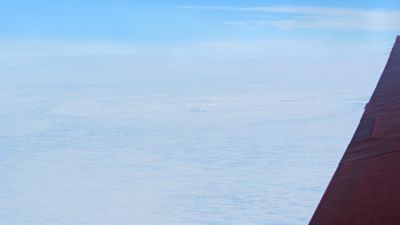
AWI scientists discover possible meteorite impact site
During their stay at the Princess Elisabeth station, researchers from the Alfred Wegener Institute, Helmholtz Centre for Polar and Marine Research (AWI) in Germany, have discovered a possible meteorite impact site during an aerial geological survey mission to study the geological history of Antarctica.
A new discovery
On December 20th, while on mission aboard AWI’s Polar 6 aircraft over the Princess Ragnhild Coast, geophysicist Christian Müller from Fielax (a company supporting the survey), looked out of the window of the aircraft and spotted an unusual formation in the ice over the King Baudoin Ice Shelf.
“About 5 or 6 kilometres away from the aircraft, I saw a massive circular structure about 2 kilometres across,” Dr Müller explained. “I wondered what could have created such a large feature in the ice.”
After returning to the Princess Elisabeth station, which AWI is using as a base of operations for the Polar 6’s survey flights this season, Dr Müller decided to have a look into the scientific literature. He wanted to know if there might be a record of some kind of impact event that happened in the vicinity of the King Baudoin Ice Shelf in recent years.
Digging deeper
After a bit of research, he found two separate studies to support the idea that the circular scar in the ice shelf could have been created by a falling meteor.
A study done by American and Canadian researchers using infrasound recordings (recordings of sound below the range of human hearing) from several sources, including Germany’s Neumayer Station III, concluded that a large body likely fell to Earth in the vicinity of the King Baudoin Ice Shelf in East Antarctica in 2004. In a separate study, scientists at Australia’s Davis station observed a dust trail high up in the atmosphere consistent with a trail left by a falling meteor. The Australians estimated that the falling object would have touched down in the area of the ice shelf.
“There are two lines of inquiry that support the hypothesis of an impact event,” affirmed Graeme Eagles, geophysicist and leader of AWI’s geophysical survey team based at the Princess Elisabeth station this season. “If the structure is indeed the result of the 2004 impact, we would expect it to have undergone about 10 years of alteration by processes such as snow accumulation, erosion by the wind, and deformation by the flow of the ice shelf itself.”
Six days after its initial discovery, AWI scientists conducted a more detailed aerial survey of the circular feature in the ice shelf, taking photos and videos, and collecting laser altimeter and radar data mapping the feature’s contours in detail.
Further investigation needed
While current evidence points to a possible meteorite impact site, the AWI team is cautious to say for certain whether the 2 kilometre-wide circular scar in the ice shelf was indeed caused by a large meteorite. AWI’s experts in Bremerhaven need to process the data the team in Antarctica has collected, and further investigation is needed.
And as the AWI team in Antarctica was sent there to conduct a geophysical survey of Antarctica’s bedrock to investigate the continent’s geological history, and not a meteorite impact site, they don’t have the means to conduct any thorough, in-situ investigation at the moment.
“If we could generate a plausible argument that this might have been the site of an impact, then we’d like to return to the site to do in-situ work,” Dr Eagles explained. “We’d certainly bring in more people to widen the range of expertise.”
More research at the site might include drilling into ice shelf to see if there is further evidence of a meteorite impact event. However it will have to wait. “We have to finish the survey we came out here to do,” Dr Eagles said. “This circular structure will have to go on the back burner until then.”
A full interview with AWI survey team leader and geophysicist Graeme Eagles is available on www.sciencepoles.org
Picture: Photo of the possible meteorite impact zone taken from AWI's Polar 6 aircraft during an aerial survey - © Tobias Binder, AWI
